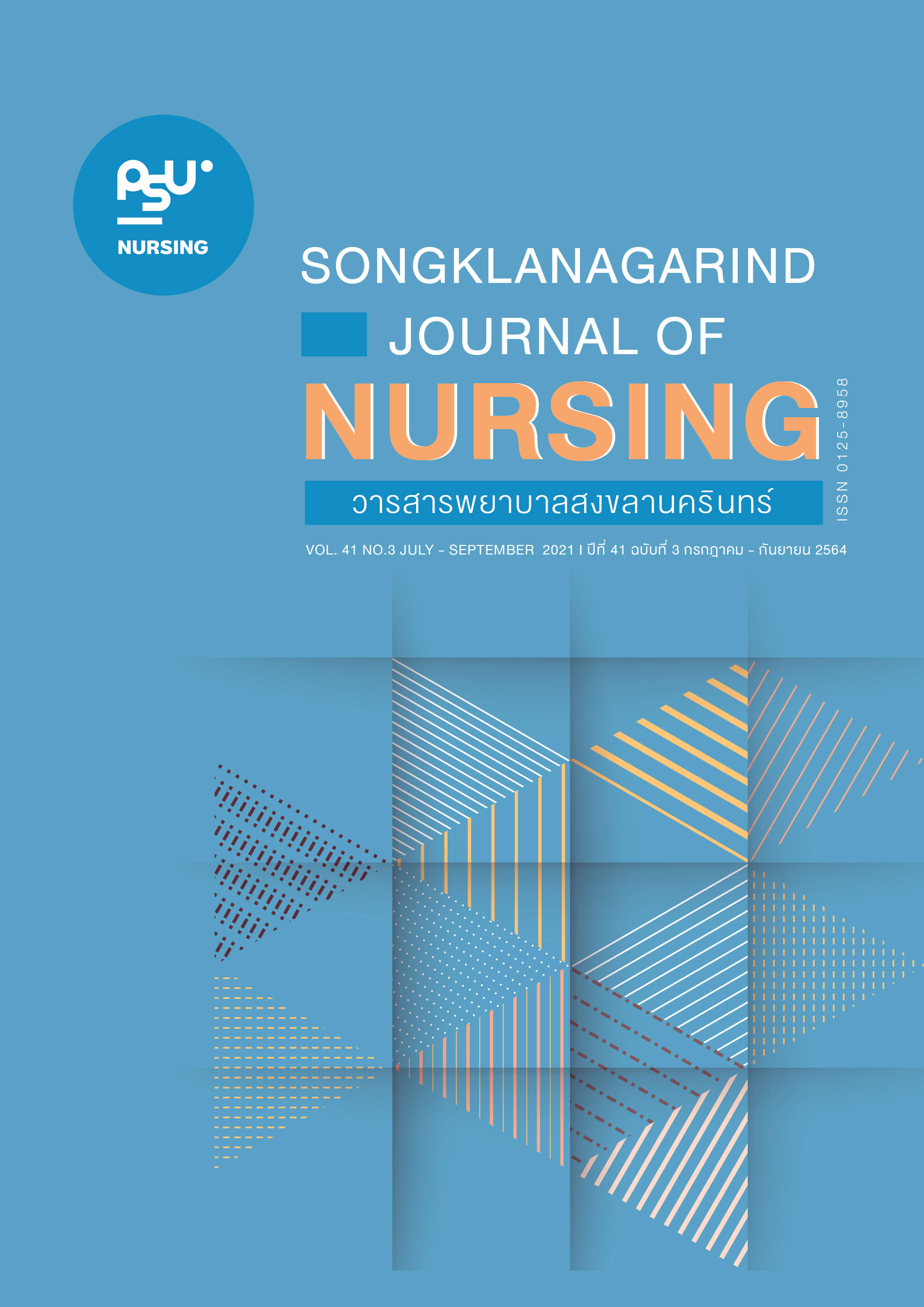Factors Associated with Registered Nurse’s Competencies in Diabetic Foot Ulcer Care in Tertiary Hospitals, Southern Thailand
Main Article Content
Abstract
Objective: The objectives of this research were to examine the level of nurse’ competencies and related factors in diabetic foot ulcer care in tertiary hospitals, southern Thailand. Methods: Sample were 135 registered nurses with at least one year of experience in caring for diabetic patients with foot ulcers. The survey used in this study consisted of 4 parts: 1) general information, 2) head nurse’ leadership, 3) supportive
system, and 4) competency of registered nurses in diabetic foot ulcer care. Part 2, 3, and 4 were approved for content validity by 5 experts. The CVI were .98, .99 and .98, respectively. The reliability coefficients were .90, .80 and .90 respectively. Data were analyzed using frequency, percentage, mean and standard deviation, and Pearson Product Moment Correlation Coefficient. Results: The overall competency of nurses in diabetic foot
ulcer care was at the high level (M = 4.14, SD = 0.50). The supporting system in working and the leadership of
head nurses had a very strong positive and a moderate positive correlation with the nurses’ competency (r = .70, and r = .43, p < .01). Conclusion: Thus the Nurse administrators should extend these results to enhance support system and improve leadership skill to enhance nurse competency in diabetic foot ulcer care.
Article Details
References
Diabetes Association of Thailand, The Endocrine Society of Thailand, and the National Health Security Office. Guidelines for the detection, prevention and treatment of foot problems in people with diabetes mellitus. Practice guidelines For diabetes in 2011. Bangkok: Srimuang; 2011. Thai.
Kumrin M. Foot wound nursing in diabetic patients: 2 Cases study. MKHJ. 2020; 17(1): 139-48. Thai.
Mahdalena M, Ningsih ESP. Effectivity of foot care education program in improving knowledge, self-efficacy
and foot care behavior among diabetes mellitus patients in Banjarbaru, Indonesia. KESMAS. 2016; 11(2): 56-60. doi: 10.21109/kesmas.v11i2.583.
Alrub AA, Hyassat D, Khader YS, et al. Factors associated with health-related quality of life among Jordanian patients with diabetic foot ulcer. Journal of Diabetes Research. 2019; 1-9. doi: https://doi.org/10.1155/2019/4706720.
American Association of Diabetes Educators. Competencies for diabetes educators A companion document to the guidelines for the practice of diabetes education [internet]. [cited 2020 Nov 23]. Available from: http://www.diabeteseducator.org.
Nursing Council. National Nursing and Midwifery Development Plan. 2 nd ed. 2007-2016. 1 st ed. Bangkok:
Siri amount of printing; 2016. Thai.
American Diabetes Association [ADA]. Diabetes basics: Diabetes statistic [internet]. 2016 [cited 2020 Nov 23].
Available from: http://www.DiabetesOrg/diabetes-statistics.
Siriyiyomchai C. Management of diabetic foot ulcers: The nurses’ roles. Journal of Nurses Association of Thailand Northern Office. 2018; 24(1): 1-14. Thai.
Seetisan P, Prachusilpa G. The competency of diabetes nurse. JOPN. 2018; 10(2): 253-61. Thai.
Kitson A, Conroy T, Wengstrom Y, et al. Defining the fundamentals of care. Int J Nurs Pract. 2010; 16(4): 423-34. doi: 10.1111/j.1440-172X.2010.01861.x.
Omachonu VK, Einspruch NG. Innovation in healthcare delivery systems: A conceptual framework. TIJ. 2010; 15(1): 1-20.
Srisathitnarakun B. Research methodology Nursing. 4 th ed. Bangkok: Chulalongkorn University; 2008. Thai.
Kouzes JM, Posner BZ. The five practices of exemplary leadership. San Francisco: Pfeiffer; 2011.
Leodoro JL, Dolores LA, Begonia CY, et al. Operative room nurse knowledge and practice of sterile technique; 2012 [cited 2020 Nov 23]. Available from: http://www.omicsgroup.org/journals/operating-room-nurses-knowledgeand-practiceof-sterike-technique.
Best JW. Research in education. New Jersey: Prentice-Hall; 1997.
Benner P. From novice to expert. Excellence and power in clinical nursing practice. Menlo Park, California CA: Addison-Wesley; 1985.
Wongwairatanakul T, Thongsuk P, Nasae T. Leadership practices of head nurses and quality culture in the
workplace perceived by head nurses and registered nurses in tertiary hospitals, Southern Thailand. Thaksin University Journal. 2011; 14(3): 229-38. Thai.
Lake ET. Development of the Practice Environment scale of the nursing work index. Res Nurs Health. 2002; 25(3): 176-88. doi: 10.1002/nur.10032.
Schermerhorn JR, Hunt JG, Osborn RN. Organizational Behavior [internet]. 1991 [cited 2020 Nov 23]. Available from: https://www.academia.edu/23478353/SCHERMERHORN_Jr_John_R_HUNT_James_G_and_OSBORN_Richard_N_
Organizational_Behavior.
Suwannaphan K. Motivation and Support. From organizations that affect the performance of their roles Duties of public health scholars at the district level [master’s minor thesis]. [Khon Kaen]: Public Health Administration Graduate school Khon Kaen University; 2008. 259 p. Thai.


